It all started when I watched some programme on TV while sitting cosily in my armchair. It was about a project that helped successfully increase the number of griffon vultures in the Uvac river canyon (West Serbia) from 2-3 pairs to as many as 8 pairs within a period of only one year! I was really impressed. I live in a country that has been trying for decades to go back to some level people say it used to have or, even more ambitiously, to reach some high level which the entire nation feels entitled to. And this has been the case for a long number of years. With no significant results. And then, all of a sudden, comes a project which manages to achieve a result that is almost 400% better than the initial state. Imagine this were an economic parameter. What a miracle it would be! On the other hand, the number of griffon vultures is some god-forsaken canyon seems like a completely irrelevant thing for most of the people and this is not something that is put on the front pages of newspapers or in breaking news, but rather it is modestly used as a reason to make some nature programme for TV which fills in a slot between news on the activities of some already forgotten politician and some already forgotten football game.
Another important element in this story is that a couple of years before the moment I’m talking about I travelled around Peru and while there I went to the Colca canyon in order to see condors which is one of the tourist attractions of southern Peru. Well, what condors constitute for Americas, griffon vultures constitute for Europe, my country included, but in my country this attracts only a small number of enthusiasts who are linked to the topic through their ornithological profession or a few lonely birds, or cuckoos, like me (both puns intended).
Since I was truly impressed by the success of the project talked about on the TV programme, I went to the internet to see who these bird experts were. I managed to find two addresses, one in Prijepolje, one in Belgrade, so I sent them emails saying I had seen the programme and would like to get in touch with them. After a couple of days I was contacted by Sasa Marinkovic from the Birds of Prey Protection Foundation (http://vulture.org.rs/). He’s professor at the Faculty of Biology at Belgrade University and his PhD thesis was on griffon vulture. Soon after the email, we met in person and have been in touch ever since.
In order to provide my contribution to the position that there is no such thing as coincidence and that God indeed works in mysterious ways, let me tell you how I actually even spoke on the phone directly to this Sasa a few years earlier. The circumstances were quite different, but it was again in connection with birds and my travels. I had just returned from Galapagos and since I used slide films for my photographs at the time, I had my photos developed with a little help from my friend. Namely, this friend had a friend who worked in a photo shop and I made this connection in order to be sure that my films would be the first in line for the development when the chemicals were at their freshest. When I went to pick up my slides, this guy told me that he couldn’t help it and had to show my photos to another friend of his who was an ornithologist and was “crazy about birds,” as photos directly from Galapagos were a relative rarity at the time (the internet still didn’t have the dimensions it has today). This was, of course, perfectly fine with me, but I did ask for a “counter favour.” So we rang this guy who was “crazy about birds” and I asked him about the proper name in Serbian for a particular bird species and then Sasa Marinkovic, because it was him, told me these beautiful birds were called “blune” (boobies). (The text on my visit to Galapagos has already been published on the website: https://www.svudapodji.com/en/ecuador-march-2004-galapagos/)
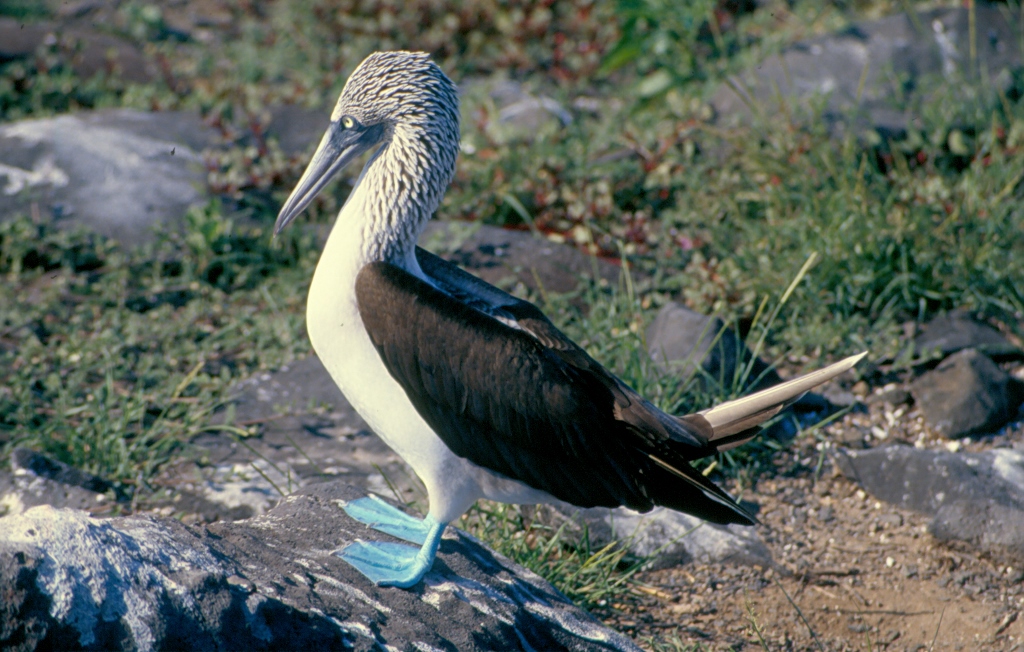 My photo of a blue-footed booby from Galapagos
My photo of a blue-footed booby from Galapagos
Although in the meantime I have started to pay more attention to birds, either at home or when I go somewhere, and although I love nature in its different aspects, I still consider myself to be far from having any passionate attachment to them (birds, I mean). Moreover, if I’m going to be honest, there are some that I truly dislike. For instance, pigeons. Just ask my friends whom until a few years ago I used to suffocate with my complaints about pigeons and they will all tell you that I positively hate our winged neighbours. Here is what it is all about. My bedroom has beautiful French windows. As early spring days start to get warmer, so do pigeons get a desire to court one another, build their nest and start a family. I don’t mind their desires, but they regularly love to come to my balcony and to start with their cooing and this is what I do mind. The frequency of their cooing is something that drives me completely crazy as I sleep. So much so, that I wake up instantaneously in a state of hysteria. Sparrows are fine, collared doves are fine, other birds and sounds are fine, but pigeons are not. They annoy me to such a degree that even when I’m half asleep I can differentiate between the sound of wings as pigeons land or take off. At first I regularly and consistently jumped out of my bed and waved them off. I hoped, in vain, that they would realize there was a completely mad woman there who continuously chased them away. No, they didn’t. I tried to comfort and calm myself by saying that my balcony probably oozed some special, good energy and that it was this that attracted them. No, that didn’t help either. Then I moved to more drastic measures, some of which entailed a serious war against pigeons in which I wasn’t too selective about the means. Nothing I did helped. Until the situation in the environment changed.
Some new birds started to fly around the building in which I live. I realized they were some birds of prey, but I had no clue which ones they were: the falcon, the goshawk or the sparrowhawk? As it turned out this was a type of falcon which has its separate name – kestrel. Kestrels occasionally utter calls at very high pitch, but this is not the sound I mind. And not only that I don’t mind it, I’ve started to cherish it. The reason? Well, ever since they’ve appeared on the scene and started to live and build nests on top of my high-rise, the pigeons have gone down to lower strata and their numbers have declined. I have become aware that before kestrels arrived pigeons had obviously bred overwhelmingly and there had been simply too many of them, both along the horizontal and along the vertical planes. The arrival of kestrels has brought pigeons to a more natural degree. And what is most important for me, they come to my balcony very rarely now and when they do come, they stay there for a very short period of time and then, before they even start to coo, I hear the clapping of wings which unmistakably means that they have just taken off.
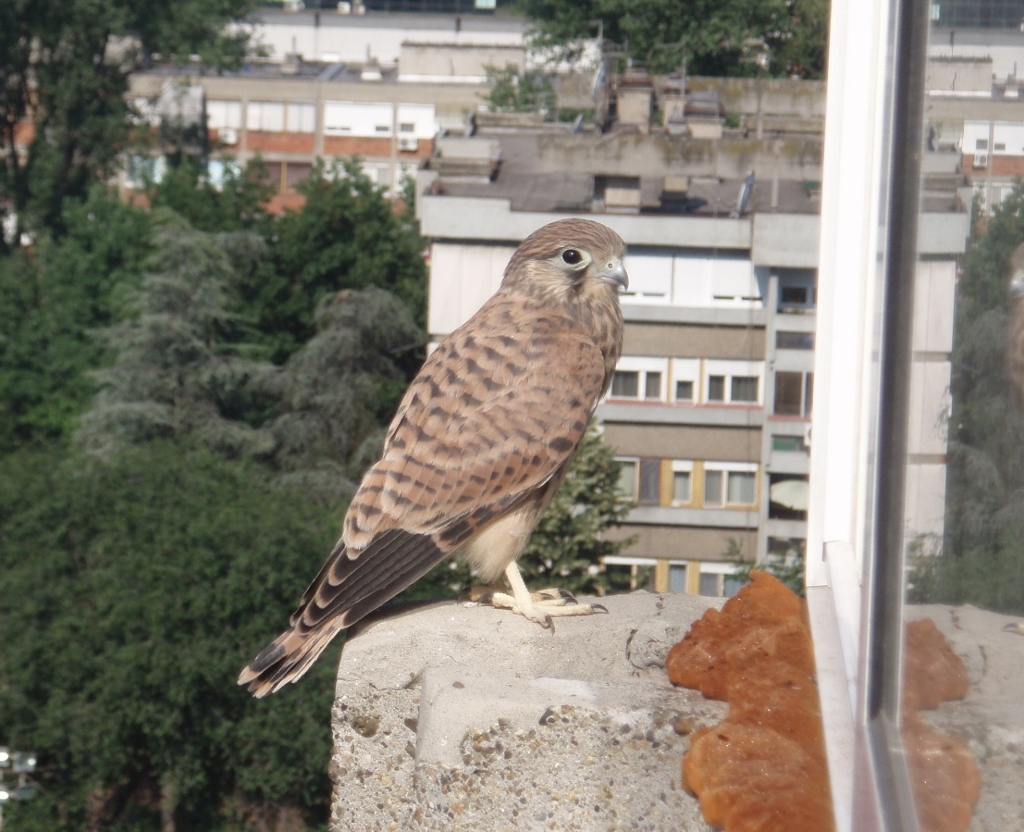 Kestrel
Kestrel
There are people who mind kestrels and their shriek calls, but it is good to know that their presence and thriving is a sure sign that the environment is healthy, since these are birds that are very sensitive to poisons and pollution, primarily through the food they take in and this usually includes small rodents who themselves feed on whatever they can find in their environment including the waste thrown away by humans.
Talking about food and waste, let me tell you another story. On a few occasions, Sasa invited me to go with them to the canyon of the Uvac river in western Serbia, but I just could not fit that into my obligations. Then once, at the beginning of a February, he called me again and started to beat around the bush before asking me if I would go with them to the Belgrade landfill where they were to count gulls. I was delighted. He still felt uncomfortable for inviting me to go to a landfill of all places, but, full of enthusiasm, I said: “That’s great! None of my friends has ever been to a landfill!” What I wanted to say was that this was quite an original and in a way unique, almost exclusive place.
The reason why ornithologists go to visit the Belgrade landfill during winter is that an impressive colony of different kinds of gulls gathers there at the time since they have a lot of food available as the bulldozers keep distributing waste and piling earth over it. Of course, since there is an enormous number of birds there, the ornithologists don’t count them one by one, especially as the gulls are not static but keep on flying up and around, going to the next lot, and so on. The technique is that they take a photo of a flock of birds and afterwards count the number of birds in the photo and multiply it by some coefficient or whatever. One of the employees of the landfill who accompanied us and took us from one place to another told us we were very lucky to go there in February when the temperature was below zero. The earth was thus mostly frozen and it also meant there was no mud. In addition, the low temperature reduced the presence and proliferation of smells that are unavoidable at such a location. All in all, the visit was very successful and to this very day I keep being happy that I was in such a special place.
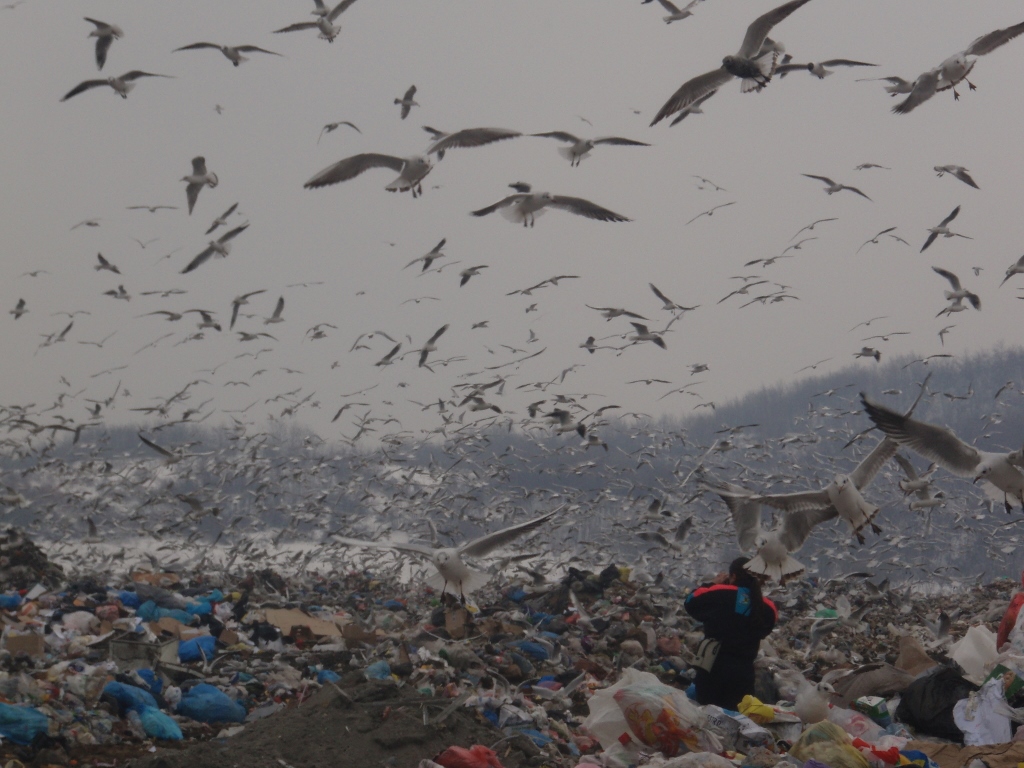 Gulls at the landfill
Gulls at the landfill
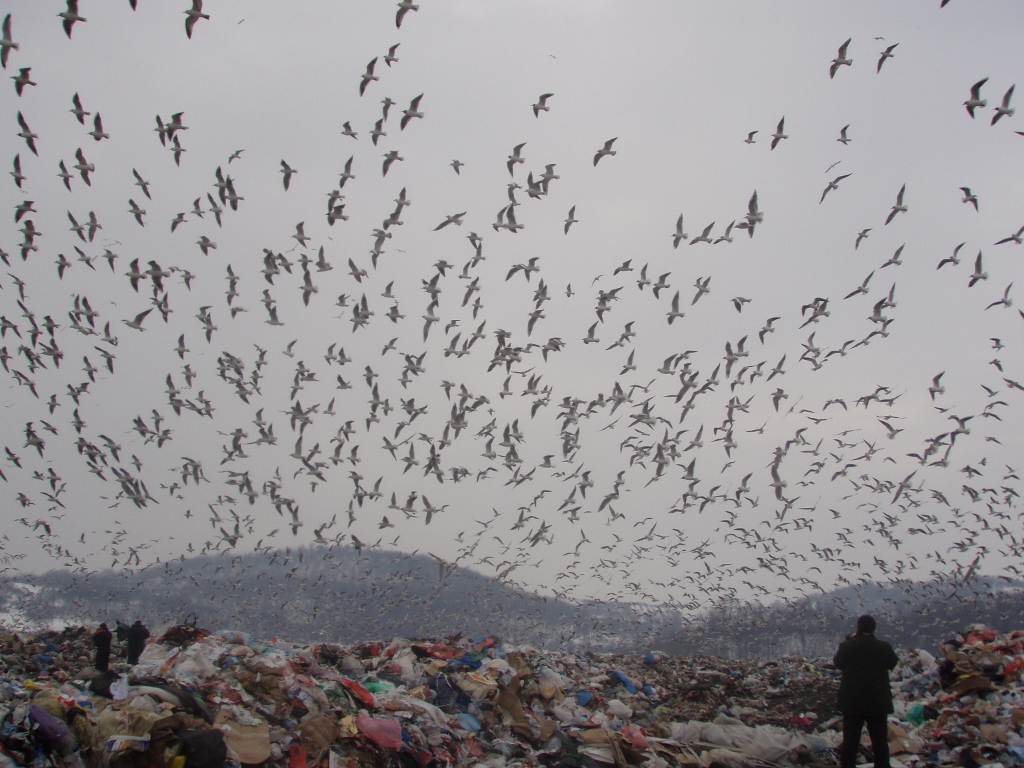 Gulls at the landfill
Gulls at the landfill
With the reduction in the number of pigeons in my surroundings, and here I’m talking about rock pigeons or feral pigeons, another good thing happened which was that in the area where I live a pair of common wood pigeons started to appear. They may have been here before, but in the past I had no interest in any kind of pigeons whatsoever. Now, I was much more open to cooperation and I also found these to be very cute for some reasons. It has even happened a couple of times that they landed in one of my flower-pots where they squashed and almost cooked my plants with their body heat, and yet I didn’t hold it against them. Still, they did not stay.
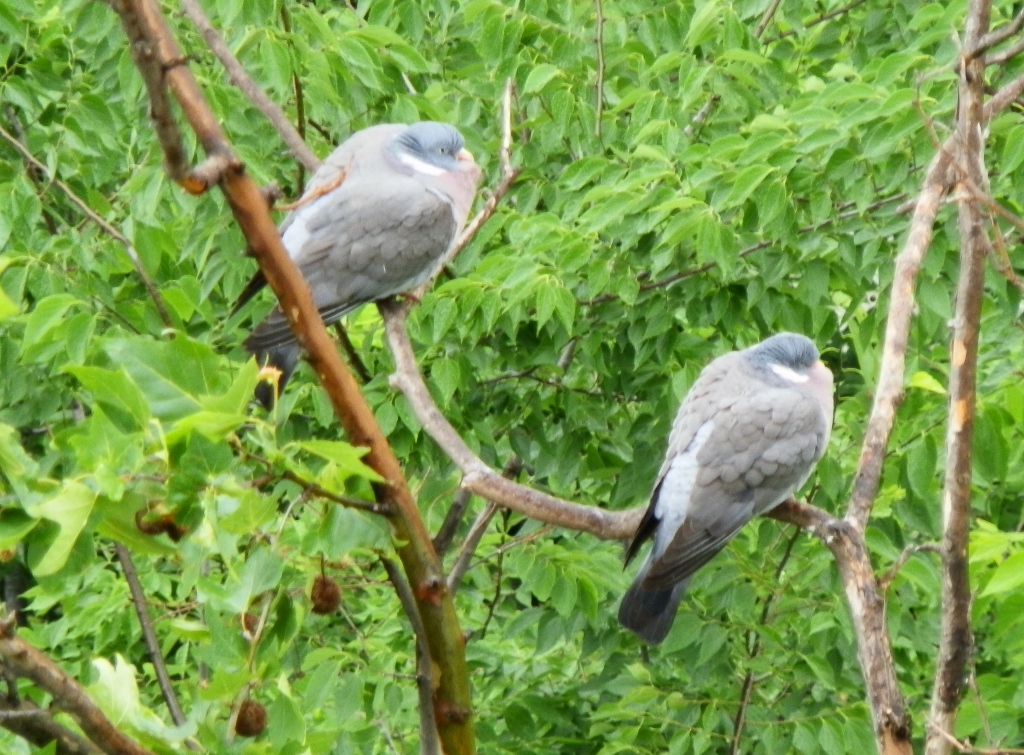 Common wood pigeons
Common wood pigeons
Over time I’ve started to pay more attention to the nature that does surround the pile of concrete I live in and this has been followed by encounters of different kind. A couple of years ago, in December that was rather mild and warm for that time of the year, I was sitting at my computer desk that is by a window, when all of a sudden I noticed something that was slowly descending on the other side of the glass. I looked a little better and then I saw a spider. And this was quite a big spider in comparison to the ones that I may come across at my flat from time to time. I realized it was coming down its own thread and that it was creating a web. The spider in question was a rather beautiful European garden spider or cross spider. In the next couple of days I monitored it intensely and was impressed by the beauty of the delicate web it had created. I even tried to steer a fly that came to my room from the balcony into the spider’s web in order to “feed” my guest, but the fly was cunning and managed to avoid all the traps. I actually liked the idea of having my personal spider, something like a pet spider, but spontaneously. Still, that warm period in December soon came to its end and I have never seen the spider since. Somehow I prefer to imagine it has gone farther along its life’s path than to think it simply froze to death.
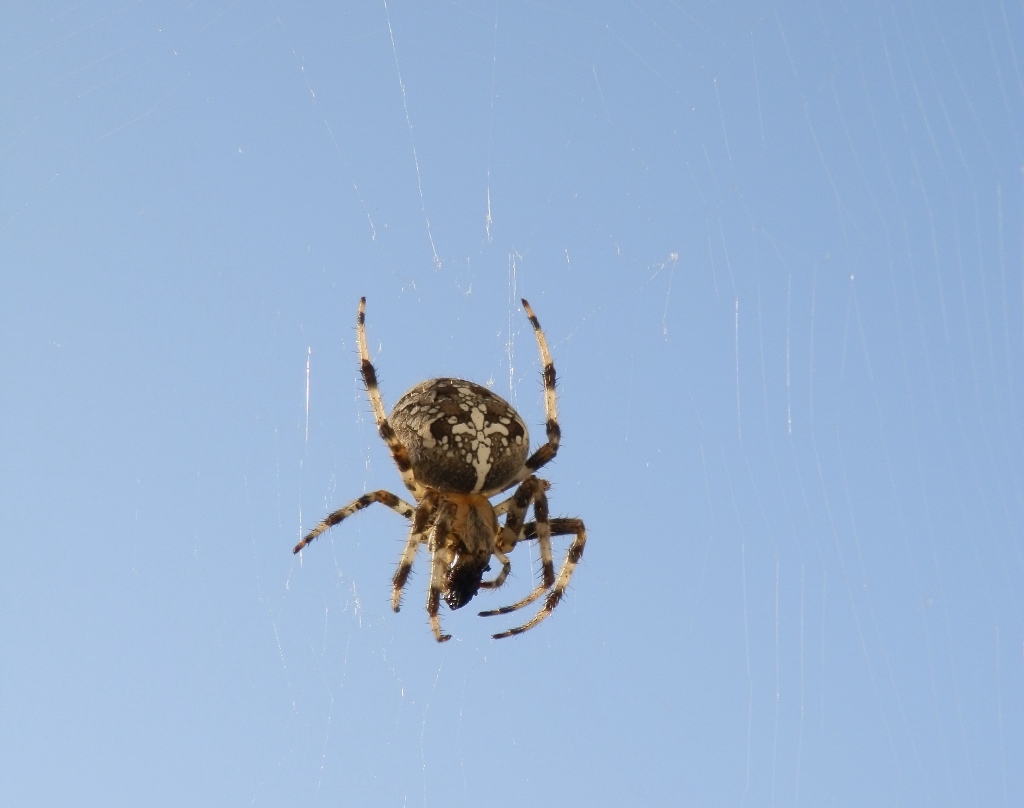 European garden spider or cross spider
European garden spider or cross spider